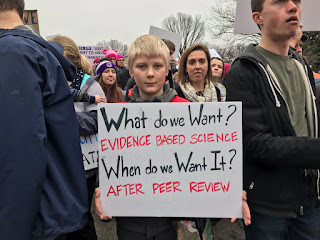 |
| Sign seen at #WomensMarchOnWashington |
The second story was, in part, about researchers, computer scientists, librarians (yeah!), archivists and students at Van Pelt Library, University of Pennsylvania. Listen to this story, which aired today, beautifully crafted by Susan Phillips of Here and Now. It is reassuring to hear professional colleagues explaining the need for metadata and archiving. Find the "bagged data" at DataRefuge.org. This sort of vigilance will be needed to keep scientific data and reports accessible - especially those funded by the government, at taxpayer expense.
The following comes from the "Rogue Scientists" story in Wired:
"But data, no matter how expertly it is harvested, isn’t useful divorced from its meaning. “It no longer has the beautiful context of being a website, it’s just a data set,” Allen says. [Laurie Allen, the assistant director for digital scholarship in the Penn libraries and the technical lead on the data rescuing event]
"That’s where the librarians came in. In order to be used by future researchers—or possibly used to repopulate the data libraries of a future, more science-friendly administration—the data would have to be untainted by suspicions of meddling. So the data must be meticulously kept under a “secure chain of provenance.” In one corner of the room, volunteers were busy matching data to descriptors like which agency the data came from, when it was retrieved, and who was handling it. Later, they hope, scientists can properly input a finer explanation of what the data actually describes."
Thank you, librarians and archivists.


